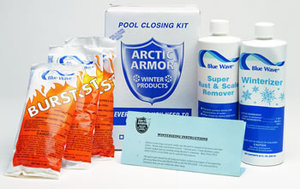How to Winterize your Pool
How to Winterize your Pool
Closing your Pool for the Winter
Taking good care of your swimming pool in the summer is important – but it’s just as important to take care during the winter months too. Maintaining a swimming pool requires some extra attention once the temperature drops, to keep the pool as clean as possible, and ensure it maintains structural integrity. Take care of your pool at the end of the summer, and help make sure it’s in great shape to use the following year.
One of the most important steps in winterizing the pool is removing water from the pump, plumbing, filter, and other structures which are sensitive to structural damage. This is crucial if you live in a location where freezing temperatures are a possibility – even if the possibility is low. Water expands when it freezes, so any water remaining in these areas may expand enough to cause damage.
Step One: Cleaning
The swimming pool should be thoroughly cleaned before any other winterizing steps are undertaken. It’s crucial to ensure that all debris is removed at this point. Ideally the pool won’t be disturbed at all over winter, so to help the winterizing chemicals do their job, the pool should be as clean as you can make it. Even a small amount of debris could allow algae to grow.
Remove all pool toys and accessories at this stage, too. Store these items in a safe place where they’ll be protected from the elements over the winter.
- Use a stiff brush on the pool’s surface then vacuum up the debris.
- Inactivate the filter before cleaning. This will make it easier if you need to clean the filter after draining.
- After cleaning, drain the pool slightly so that the water level is just below the skimmer. This will ensure that if the skimmer won’t be damaged by expanding water if temperatures drop. Alternatively you can opt to fit the skimmer with an Aquador, which prevents water entering the skimmer over winter.
Step Two: Add Winterizing Chemicals
Test pH, calcium hardness, and total alkalinity. Balancing the water one final time before winter sets in will help ensure that the pool’s interior is protected from damage and staining.
Next, use a chemical winterizing kit. These kits, when applied to your pool’s water, will help prevent it clouding up over the winter. Most kits differ slightly depending on the manufacturer, so be sure to follow your particular kit’s instructions closely
- Don’t use bromine or chlorine tablets to balance the water at this time. They may not dissolve properly, and the concentrated chemical may damage the pool’s interior. High levels of chlorine may also interfere with algaecidal chemicals.
- Don’t use a floater containing chlorine or bromine, as these may also damage the pool.
Step Three: Drain the Plumbing
Next, water should be drained or blown out of the plumbing lines, pump, heating system, and filter. Blowing is more effective than simple drainage, as blowing will ensure the removal of smaller water droplets that might remain after draining.
- You can opt to turn the pump on for no longer than a few seconds after it has been drained. This will help remove any remaining water. If you choose to take this step make sure it really is only a couple of seconds – running the pump in the absence of water can destroy the seal quickly.
- You can also remove the pump entirely and store it inside over winter to ensure it’s completely protected.
- Once water has been removed, all plugs and hoses in the various systems can be removed, cleaned, and stored. These should not be allowed to remain attached, as they may prevent proper draining if water collects in these systems over winter.
- It’s a good idea to do a maintenance check at this time – repairs can be done now, or after winter is over. Remember to check plugs and hoses for damage too, as this is the perfect time to replace these items.
Step Four: Cover the Pool
Double-check to make sure every task is completed, and then cover the pool. To ensure the swimming pool stays clean and free from algal growth over the winter, use a solid cover, as this will block both sunlight and debris. A mesh cover can be used, and this will prevent leaves and other large debris from getting into the water. However, the water won’t be protected from dirt and other debris, or from sunlight. Essentially, using a solid cover over winter means less work is needed to make the pool usable in the summer.
Consider using an air pillow. These items sit on top of the surface of the water, beneath the pool cover. Adding an air pillow turns the cover surface into a dome-shaped structure, so that excess debris, water, and snow will not collect on the cover.
With these steps taken, your swimming pool will be protected from winter damage, and the task of opening the pool up will be much easier when the weather grows warmer.
